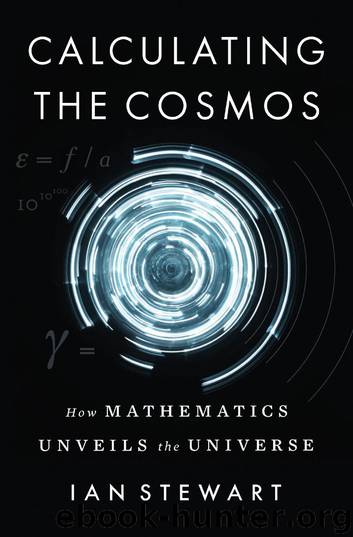Calculating the Cosmos by Ian Stewart

Author:Ian Stewart
Language: eng
Format: epub, azw3
Publisher: Basic Books
Published: 2016-09-29T00:00:00+00:00
Observed light curve of Delta Cephei.
Cepheids were the long-sought standard candle. Together with the associated yardstick – the formula describing how a star’s apparent brightness varies with distance – they allowed us to take another step up the cosmic distance ladder. Each step involved a mixture of observations, theory, and mathematical inference: numbers, geometry, statistics, optics, astrophysics. But the final step – a truly giant one – was yet to come.
12
Great Sky River
See yonder, lo, the Galaxy,
Which men call the Milky Way,
For it is white.
Geoffrey Chaucer, The House of Fame
IN ANCIENT TIMES there was no street lighting beyond the occasional torch or fire, and it was virtually impossible not to notice one amazing feature of the heavens. Today the only way to see it is to live in, or visit, a region where there’s little or no artificial lighting. Most of the night sky is dusted with bright pinpoints of stars, but across the whole thing runs a broad, irregular band of light, more like a river than a scatter of glowing points. Indeed, to the ancient Egyptians it was a river, the celestial analogue of the Nile. Today we still call it the Milky Way, a name that reflects its puzzling form. Astronomers call the cosmic structure that creates it the Galaxy, a word derived from the ancient Greek names galaxias (milky one) and kyklos galaktikos (milky circle).
It took millennia for astronomers to realise that this milky smear across the sky is, despite appearances, a gigantic band of stars, so distant that the eye can’t resolve them into individual points. This band is actually a lens-shaped disc, seen edge-on, and we’re inside it.
As astronomers surveyed the heavens with ever more powerful telescopes, they noticed other faint smudges, quite unlike stars. A few are visible to a keen eye: the tenth-century Persian astronomer Abd al-Rahman al-Sufi described the Andromeda Galaxy as a small cloud, and in 964 he included the Large Magellanic Cloud in his Book of Fixed Stars. Originally, western astronomers called these faint, fuzzy wisps of light ‘nebulas’.
Download
This site does not store any files on its server. We only index and link to content provided by other sites. Please contact the content providers to delete copyright contents if any and email us, we'll remove relevant links or contents immediately.
Modelling of Convective Heat and Mass Transfer in Rotating Flows by Igor V. Shevchuk(6225)
Weapons of Math Destruction by Cathy O'Neil(5831)
Factfulness: Ten Reasons We're Wrong About the World – and Why Things Are Better Than You Think by Hans Rosling(4487)
Descartes' Error by Antonio Damasio(3166)
A Mind For Numbers: How to Excel at Math and Science (Even If You Flunked Algebra) by Barbara Oakley(3103)
Factfulness_Ten Reasons We're Wrong About the World_and Why Things Are Better Than You Think by Hans Rosling(3046)
TCP IP by Todd Lammle(3013)
Applied Predictive Modeling by Max Kuhn & Kjell Johnson(2907)
Fooled by Randomness: The Hidden Role of Chance in Life and in the Markets by Nassim Nicholas Taleb(2861)
The Tyranny of Metrics by Jerry Z. Muller(2849)
The Book of Numbers by Peter Bentley(2779)
The Great Unknown by Marcus du Sautoy(2538)
Once Upon an Algorithm by Martin Erwig(2473)
Easy Algebra Step-by-Step by Sandra Luna McCune(2469)
Lady Luck by Kristen Ashley(2416)
Practical Guide To Principal Component Methods in R (Multivariate Analysis Book 2) by Alboukadel Kassambara(2380)
Police Exams Prep 2018-2019 by Kaplan Test Prep(2358)
All Things Reconsidered by Bill Thompson III(2261)
Linear Time-Invariant Systems, Behaviors and Modules by Ulrich Oberst & Martin Scheicher & Ingrid Scheicher(2233)
